Klasifikasi Covid-19 Pada Citra CT Scans Paru-Paru Menggunakan Metode Convolution Neural Network
Abstract
Abstrak. Salah satu cara yang dapat digunakan untuk deteksi dini Covid-19 adalah dengan pemeriksaan radiologis menggunakan CT scans paru-paru, karena gejala yang terjadi saat terinfeksi Covid-19 berupa gangguan pernapasan akut. Covid-19 sulit dibedakan dari pneumonia yang disebabkan oleh virus influeza A, virus influenza cytomegalovirus, adenovirus, respiratory syncytial virus, SARS-CoV, MERS coronavirus. Penelitian ini mengembangkan teknik analisis citra CT scans paru-paru menggunakan teknik Deep Learning, dengan menggunakan metode Convolutional Neural Network (CNN) untuk mendukung hasil analisis dari radiolog ataupun menjadi second opinion dari radiolog. Penellitian ini juga menguji kinerja metode CNN dalam melakukan klasifikasi citra CT scans paru-paru. Dataset yang digunakan terdiri dari 3216 data. Berdasarkan hasil pengujian diperoleh akurasi dengan rata-rata 100% untuk setiap epoch yang diberikan. Dari hasil pengujian dapat disimpulkan bahwa Metode CNN dapat digunakan untuk membedakan citra CT scans untuk Covid-19 dan citra CT scans normal.
Kata kunci: Jaringan saraf konvolusi; Deep Learning; CT scans Paru-paru; Citra Covid-19.
Â
Abstract. One way that can be used for early detection of Covid-19 is by radiological examination using CT scans of the lungs, because the symptoms that occur when infected with Covid-19 are acute respiratory disorders. Covid-19 is difficult to distinguish from pneumonia caused by influenza A virus, influenza cytomegalovirus virus, adenovirus, respiratory syncytial virus, SARS-CoV, MERS coronavirus. This study developed an image analysis technique for CT scans of the lungs using Deep Learning techniques, using the Convolutional Neural Network (CNN) method to support the results of the analysis from the radiologists or as a second opinion from the radiologists. This study also tested the performance of the CNN method in classifying CT scans of the lungs. The dataset used consists of 3216 data. Based on the test results obtained an average accuracy of 100% for each given epoch. From the test results, it can be concluded that the CNN method can be used to distinguish CT scan images for Covid-19 and normal CT scan images.
Keywords: Convolutional neural network; Deep Learning; CT scans Lungs; Image of Covid-19.
References
WHO, “WHO Coronavirus (COVID-19) Dashboard,†2021. https://covid19.who.int/ (accessed Apr. 06, 2021).
WHO, “Tes Diagnostik untuk SARS-CoV-2: Panduan interim,†World Heal. Organ., no. September, pp. 1–19, 2020.
E. Irmak, “Implementation of convolutional neural network approach for COVID-19 disease detection,†Physiol. Genomics, vol. 52, no. 12, pp. 590–601, 2020, doi: 10.1152/physiolgenomics.00084.2020.
K. Ramanathan et al., “Clinical features of patients infected with 2019 novel coronavirus in Wuhan, China,†Lancet, vol. 395, no. January, pp. 497–506, 2020.
C. B. S. Maior, J. M. M. Santana, I. D. Lins, and M. J. C. Moura, “Convolutional neural network model based on radiological images to support COVID-19 diagnosis: Evaluating database biases,†PLoS One, vol. 16, no. 3 March, pp. 1–25, 2021, doi: 10.1371/journal.pone.0247839.
W. C. Dai et al., “CT Imaging and Differential Diagnosis of COVID-19,†Can. Assoc. Radiol. J., vol. 71, no. 2, pp. 195–200, 2020, doi: 10.1177/0846537120913033.
B. W. and L. C. Y. F. Riti, H. A. Nugroho, S. Wibirama, “Feature extraction for lesion margin characteristic classification from CT Scan lungs image,†2016 1st Int. Conf. Inf. Technol. Inf. Syst. Electr. Eng., pp. 54–58, 2016, doi: 10.1109/ICITISEE.2016.7803047.
D. Singh, V. Kumar, Vaishali, and M. Kaur, “Classification of COVID-19 patients from chest CT images using multi-objective differential evolution–based convolutional neural networks,†Eur. J. Clin. Microbiol. Infect. Dis., vol. 39, no. 7, pp. 1379–1389, 2020, doi: 10.1007/s10096-020-03901-z.
S. Serte and H. Demirel, “Since January 2020 Elsevier has created a COVID-19 resource centre with free information in English and Mandarin on the novel coronavirus COVID- 19 . The COVID-19 resource centre is hosted on Elsevier Connect , the company ’ s public news and information,†Comput. Biol. Med., vol. 132, no. January, 2021, doi: 104306.
M. Sahu and R. Dash, A survey on deep learning: Convolution neural network (cnn), vol. 153, no. September 2020. Springer Singapore, 2021.
M. A. Hossain and M. S. Alam Sajib, “Classification of Image using Convolutional Neural Network (CNN),†Glob. J. Comput. Sci. Technol., vol. 19, no. 2, pp. 13–18, 2019, doi: 10.34257/gjcstdvol19is2pg13.
T. D. Pham, “A comprehensive study on classification of COVID-19 on computed tomography with pretrained convolutional neural networks,†Sci. Rep., vol. 10, no. 1, pp. 1–8, 2020, doi: 10.1038/s41598-020-74164-z.
A. Jaiswal, N. Gianchandani, D. Singh, V. Kumar, and M. Kaur, “Classification of the COVID-19 infected patients using DenseNet201 based deep transfer learning,†J. Biomol. Struct. Dyn., vol. 0, no. 0, pp. 1–8, 2020, doi: 10.1080/07391102.2020.1788642.
V. Shah, R. Keniya, A. Shridharani, M. Punjabi, J. Shah, and N. Mehendale, “Diagnosis of COVID-19 using CT scan images and deep learning techniques,†Emerg. Radiol., 2021, doi: 10.1007/s10140-020-01886-y.
W. Swastika, P. Studi, T. Informatika, and P. Korespondensi, “Studi Awal Deteksi Covid-19 Menggunakan Citra CT Berbasis Deep Preminary Studi Of Covid-19 Detection Using CT Image Based On,†vol. 7, no. 3, pp. 629–634, 2020, doi: 10.25126/jtiik.202073399.
R. M. James, Kusrini, and M. R. Arief, “Classification of X-ray COVID-19 Image Using Convolutional Neural Network,†2020 2nd Int. Conf. Cybern. Intell. Syst. ICORIS 2020, 2020, doi: 10.1109/ICORIS50180.2020.9320828.
S. Syamsuddin, K. alloto dang, R. Andi Djamro, and Ahyuna, “Literatur Riview Artificial Intelegence Deteksi Hasil CT Scan Paru-Paru Pasien Terjangkit Covid-19,†Angew. Chemie Int. Ed., vol. 2, 2021.
Abu Zahid Bin Aziz, “CT Scans for COVID-19 Classification,†2020. https://www.kaggle.com/azaemon/preprocessed-ct-scans-for-covid19 (accessed May 07, 2021).
I. M. D. Maysanjaya, “Klasifikasi Pneumonia pada Citra X-rays Paru-paru dengan Convolutional Neural Network,†J. Nas. Tek. Elektro dan Teknol. Inf., vol. 9, no. 2, pp. 190–195, 2020, doi: 10.22146/jnteti.v9i2.66.
R. K. Putri, “Implementasi Deep Learning Menggunakan Metode Convolutional Neural Network untuk Klasifikasi,†in Tugas Akhir, Yogyakarta, 2018.
Y. Tang, “Deep Learning using Linear Support Vector Machines,†no. Icml, 2013, [Online]. Available: http://arxiv.org/abs/1306.0239.
S. Ilahiyah and A. Nilogiri, “Implementasi Deep Learning Pada Identifikasi Jenis Tumbuhan Berdasarkan Citra Daun Menggunakan Convolutional Neural Network,†JUSTINDO (Jurnal Sist. dan Teknol. Inf. Indones., vol. 3, no. 2, pp. 49–56, 2018.
How To Cite This :
Refbacks
- There are currently no refbacks.










